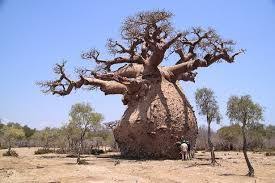The KuKa Tree

Growing up in the sub-Saharan Savannah region of North Nigeria where temperatures fluctuate annually between 15°C and 40°C and where red dust from the Sahara Desert pretty much covers everything in its path during the Harmattan season has definitely reaped dividends and symbolic references. Dotted amidst the mostly barren landscape are mighty African Baobab trees, the oldest of them being around 1500 years. Some have hollowed-out trunks, ideal location for many a hide-and-seek game amongst children. The Kuka tree’s egg-shaped fruit pods contain kidney-shaped seeds and dried delicious white flaky pulp which tastes better than modern-day chocolate, salted-caramel or toffee confectioneries, with many boisterous children at play consuming much of the “Low-Cost” fruit pulp. Baobab juice (made by soaking the fruit pulp in water) is also very nourishing and refreshing.
Kuka tree trunks are massive (up to 14 metres in diameter) and were used by 15th to 18th-century explorers as natural canvass for their antiquated ancient drawings and by up-and-coming Banksys for their modern graffiti. The branches resemble the digits of the hand (its scientific name is Adansonia digitata) leading to the Kuka tree being nicknamed the “upside-down tree”, a “Game-Changer”.
They can grow as high as 25 metres, with their root span exceeding their height giving them “Global Reach” and “Robust Performance” as they seek for water, the key to their survival in a dry arid climate. In many cases, sighting them from afar can indicate that a water source or a water way is close by, so they are a source of “Connectivity”. They are not found in deep sandy areas, waterlogged vicinities or frosty regions, so they are “Frequency-Specific” and “Region-Specific”.
Animals (baboons, elephants and rhinoceroses) eat the seeds, barks and leaves (“Reception”) and also help to disperse the seeds over long distances (“Transmission”). Their flowers are also pollinated by echolocating fruit bats (“Phased Arrays”). There are many legends (“Beam-Forming Algorithms”) associated with the Kuka tree. Lately, Kuka fruit pulp is being used as ingredients in smoothies and cereal bars (“Relevance”and“Maturity”).
This is where the Tetrivis KuKa family of chipsets for LEOSAT Market gets its name and characteristics from. The TRV003 (Rx) and TRV004 (Tx), the first chipsets in the family, taped out for fabrication on 30th September 2020. Both chips support four Ku-Band Dual-Beam and Dual-Polarisation Rx RF-to-Baseband and Tx Baseband-to-RF paths with limited conceptual support for Ka-Band frequencies. Detailed testing will commence on the engineering samples in January 2021, with customer Evaluation Boards available for order in Q1 2021. Just like the African Baobab tree or Kuka tree, “The future is indeed bright” for Tetrivis KuKa chipset family. “And the future is LEOSAT and high-performance RFIC/mm-Wave enabling technologies”.
